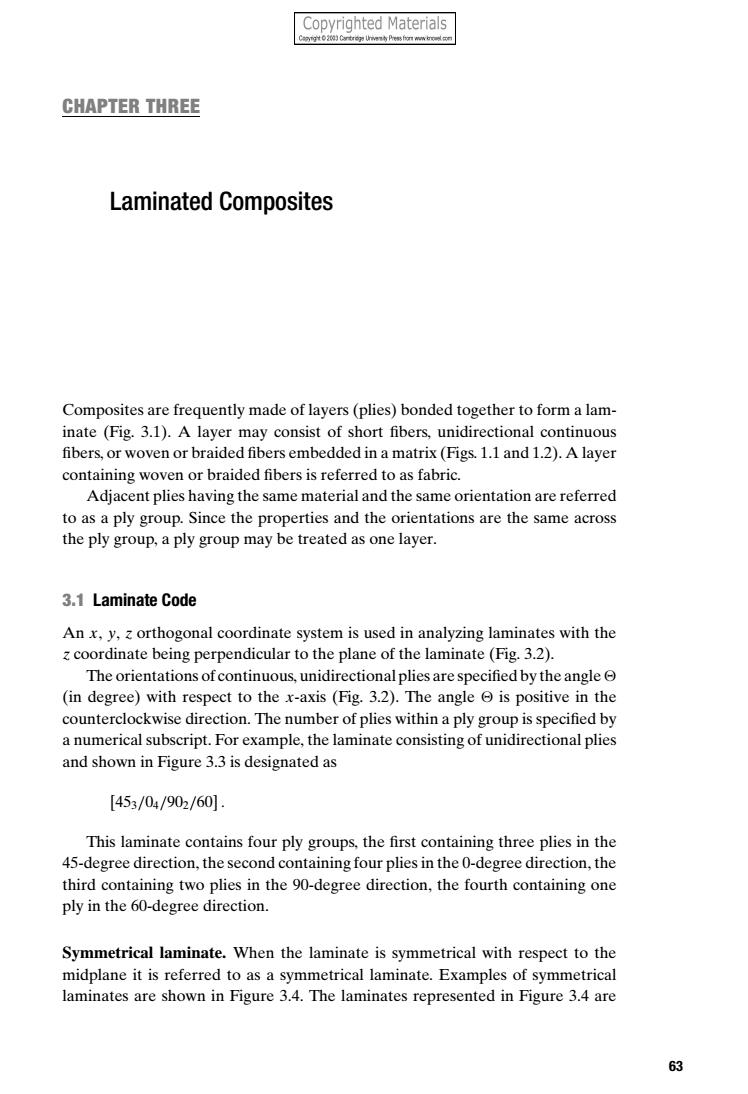正在加载图片...

Copyrighted Materials 0CrpUPress o CHAPTER THREE Laminated Composites Composites are frequently made of layers(plies)bonded together to form a lam- inate (Fig.3.1).A layer may consist of short fibers,unidirectional continuous fibers,or woven or braided fibers embedded in a matrix(Figs.1.1 and 1.2).A layer containing woven or braided fibers is referred to as fabric. Adjacent plies having the same material and the same orientation are referred to as a ply group.Since the properties and the orientations are the same across the ply group,a ply group may be treated as one layer. 3.1 Laminate Code An x,y,z orthogonal coordinate system is used in analyzing laminates with the z coordinate being perpendicular to the plane of the laminate(Fig.3.2). The orientations of continuous,unidirectional plies are specified by the angle (in degree)with respect to the x-axis (Fig.3.2).The angle is positive in the counterclockwise direction.The number of plies within a ply group is specified by a numerical subscript.For example,the laminate consisting of unidirectional plies and shown in Figure 3.3 is designated as [453/04/902/60] This laminate contains four ply groups,the first containing three plies in the 45-degree direction,the second containing four plies in the 0-degree direction,the third containing two plies in the 90-degree direction,the fourth containing one ply in the 60-degree direction. Symmetrical laminate.When the laminate is symmetrical with respect to the midplane it is referred to as a symmetrical laminate.Examples of symmetrical laminates are shown in Figure 3.4.The laminates represented in Figure 3.4 are 63CHAPTER THREE Laminated Composites Composites are frequently made of layers (plies) bonded together to form a laminate (Fig. 3.1). A layer may consist of short fibers, unidirectional continuous fibers, or woven or braided fibers embedded in a matrix (Figs. 1.1 and 1.2). A layer containing woven or braided fibers is referred to as fabric. Adjacent plies having the same material and the same orientation are referred to as a ply group. Since the properties and the orientations are the same across the ply group, a ply group may be treated as one layer. 3.1 Laminate Code An x, y, z orthogonal coordinate system is used in analyzing laminates with the z coordinate being perpendicular to the plane of the laminate (Fig. 3.2). The orientations of continuous, unidirectional plies are specified by the angle (in degree) with respect to the x-axis (Fig. 3.2). The angle is positive in the counterclockwise direction. The number of plies within a ply group is specified by a numerical subscript. For example, the laminate consisting of unidirectional plies and shown in Figure 3.3 is designated as [453/04/902/60] . This laminate contains four ply groups, the first containing three plies in the 45-degree direction, the second containing four plies in the 0-degree direction, the third containing two plies in the 90-degree direction, the fourth containing one ply in the 60-degree direction. Symmetrical laminate. When the laminate is symmetrical with respect to the midplane it is referred to as a symmetrical laminate. Examples of symmetrical laminates are shown in Figure 3.4. The laminates represented in Figure 3.4 are 63